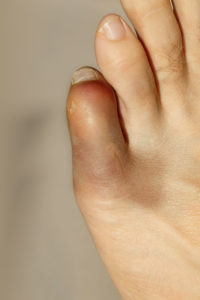 We’ve all done it. At some point in our life, we’ve misjudged a step and stubbed a toe against a piece of furniture. Oftentimes it happens to your big toe, and we’ talked about the difference between broken big toes and stubbed toes on this related blog. Your big toe is much more stable and strong than your other toes, so while you can break it by stubbing it, that’s usually not the case.
We’ve all done it. At some point in our life, we’ve misjudged a step and stubbed a toe against a piece of furniture. Oftentimes it happens to your big toe, and we’ talked about the difference between broken big toes and stubbed toes on this related blog. Your big toe is much more stable and strong than your other toes, so while you can break it by stubbing it, that’s usually not the case.
The same can’t be said for your other toes. Aside from your big toe, your pinky toe is probably the most common toe that gets stubbed or experiences trauma because it is on the end of your foot. Your pinky is more fragile that your big toe, so what happens if you catch your bare foot on the corner of your desk? Today, we explain how to care for broken pinky toes.
Treating Broken Pinky Toes
The good thing about treating broken pinky toes is that unless it’s an open fracture (where you can see the bone), you’re probably not going to need surgery. The vast majority of little toe fractures heal on their own with conservative care measures, but that doesn’t mean you can just grit your teeth and expect it to heal perfectly. But before we get into some treatment and care techniques, let’s take a look at some of the symptoms of a broken pinky toe:
- Sharp pain, especially when bearing weight
- Bruising
- Discoloration
- Swelling
- Warmer than other toes to the touch
- Disjointed appearance
If you’re dealing with the above symptoms, odds are you’re dealing with a broken pinky toe or at least a deep bruise. However, this typically isn’t a condition worth a trip to the doctor’s office. We love to help patients heal, but odds are we’re just going to tell you in person the same things that we’re telling you right here, so save yourself some time and money by just following these care guidelines.
The key to helping a broken pinky toe heal is to try and take as much weight off the toe as possible. Use crutches or a walking boot if they help, but some people prefer a more minimalistic approach, like by stuffing a cotton ball in their shoe to soften the force of each step. Also, since your toe may be swollen for a few days, opt for a looser fitting shoe to give it more room to breathe. When you’re not upright, try to keep the foot elevated.
Another thing you may find helpful is to buddy tape the injured toe to the adjacent toe. Again, consider sticking a small cotton ball underneath the toe before you tape them together, as this will act as a shock absorber while the adjacent toe will act like a splint to protect the pinky toe from injury. If pain is problematic, consider an over-the-counter pain reliever for the first couple of days. Odds are you’ll notice some improvements in the first 48 hours, but it’s not uncommon for pain to dull over the course of a couple of weeks.
If, however, pain worsens or you’re still dealing with pain after a month, set up a visit with a foot specialist. There’s a chance that a bone didn’t heal correctly, or something else is going on in your foot. Your doctor can have a look and provide a more case-specific treatment plan.